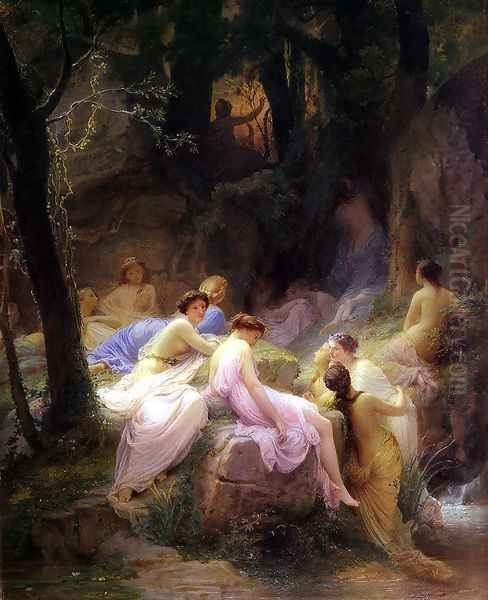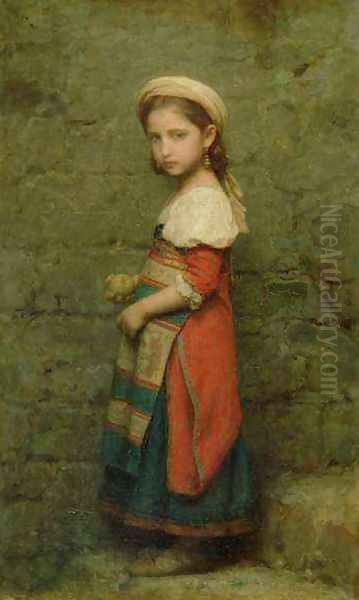Charles François Jalabert (1819-1901) stands as a significant, if sometimes overlooked, figure in the landscape of 19th-century French art. A product of the rigorous French Academic system, Jalabert carved out a successful career, excelling in portraiture, historical scenes, and religious subjects. His work embodies the technical polish, idealized forms, and narrative clarity prized by the Academy, offering a window into the dominant artistic tastes of his era, even as new, more radical movements began to challenge its supremacy.
Early Life and Artistic Awakening in Nîmes
Born on January 1, 1819, in Nîmes, a city in southern France steeped in Roman history with architectural marvels like the Maison Carrée and the Arena, Charles François Jalabert's early environment may well have subtly influenced his later predilection for classical and historical themes. His initial artistic inclinations were nurtured locally, likely at the Nîmes drawing school, before he made the pivotal move to Paris, the undisputed center of the European art world.
This relocation was crucial for any aspiring artist with serious ambitions. Paris offered access to the prestigious École des Beaux-Arts, the official state-sponsored art school, and the studios of established masters. It was here that Jalabert's formal artistic education would truly begin, shaping his technique and aesthetic philosophy for decades to come.
Under the Wing of Paul Delaroche
In 1839, Jalabert entered the esteemed studio of Paul Delaroche (1797-1856). Delaroche was a towering figure in French art, himself a student of Antoine-Jean Gros, who in turn had studied with Jacques-Louis David. Delaroche was celebrated for his meticulously rendered historical scenes, often characterized by their dramatic intensity and theatrical staging, such as "The Execution of Lady Jane Grey" or "Napoleon Crossing the Alps." He was a master of what was known as the juste milieu (middle way), blending aspects of Neoclassicism and Romanticism.

Studying under Delaroche provided Jalabert with a thorough grounding in academic principles: a strong emphasis on drawing (disegno), anatomical accuracy, balanced composition, and a smooth, highly finished surface. Delaroche's studio was a vibrant hub, attracting talented students from across Europe and America, including Jean-Léon Gérôme, Thomas Couture, and Charles-Auguste Mengin, who would also become notable figures in their own right. The competitive yet collaborative environment of such a studio was instrumental in honing an artist's skills.
Jalabert's talent was soon recognized. In 1841, he achieved a significant early success by winning the second Grand Prix de Rome for painting. While not the first prize, this was still a prestigious award from the Académie des Beaux-Arts, offering the recipient the opportunity to study at the French Academy in Rome, located in the Villa Medici. This period of study in Italy was considered essential for an academic artist, allowing for direct engagement with the masterpieces of antiquity and the Renaissance.
The French Academic Tradition and the Salon
To understand Jalabert's career, one must appreciate the dominance of the French Academic system in the 19th century. The Académie des Beaux-Arts, an institution with roots stretching back to the 17th century, dictated artistic standards, controlled art education, and, crucially, managed the Paris Salon. The Salon was an annual (or biennial) juried exhibition that was, for most of the century, the primary venue for artists to display their work, gain critical attention, attract patrons, and secure commissions.
Success at the Salon could make an artist's career. The system favored "history painting" – large-scale depictions of biblical, mythological, or historical subjects – as the noblest genre, followed by portraiture, genre scenes, landscape, and still life. Artists like Jean-Auguste-Dominique Ingres, a staunch defender of classical ideals and Delaroche's own teacher, and later figures such as William-Adolphe Bouguereau and Alexandre Cabanel, became immensely successful and influential through their mastery of the academic style and their triumphs at the Salon. Jalabert aspired to and achieved success within this framework.
Rise to Prominence: Portraits and Historical Narratives
Jalabert began exhibiting at the Paris Salon in 1842 and quickly established a reputation for his refined technique and elegant compositions. His portraits were particularly sought after, praised for their likeness, sophisticated rendering of textures, and ability to capture the sitter's character and social standing. He received commissions from prominent families, including members of the Orléans dynasty, the former French royal family. These portraits were not merely likenesses but carefully constructed images of status and refinement.
![The Plague of Thebes [detail #1] by Charles Francois Jalabert](https://www.niceartgallery.com/imgs/198511/m/charles-francois-jalabert-the-plague-of-thebes-detail-1-248f39a9.jpg)
Beyond portraiture, Jalabert dedicated himself to historical and mythological paintings, genres highly esteemed by the Academy. One of his most notable works in this vein is The Plague of Thebes (La Peste de Thèbes), exhibited at the Salon of 1849. Inspired by Sophocles' tragedy Oedipus Rex, the painting depicts the suffering city of Thebes, afflicted by a divinely sent plague as a consequence of unsolved regicide and hidden sin. The work showcases Jalabert's skill in composing complex multi-figure scenes, his anatomical knowledge, and his ability to convey dramatic tension and pathos, all hallmarks of successful history painting.
Another significant work exploring the Theban cycle is Antigone Leads Oedipus out of Thebes (Antigone conduit Œdipe hors de Thèbes). This painting, likely depicting the blind, exiled king guided by his devoted daughter, would have resonated with contemporary audiences familiar with classical literature and its moral lessons. Such themes of duty, suffering, and fate were common in academic art.
Religious Themes and Lyrical Compositions
Jalabert also engaged with religious subjects, a staple of academic art that provided opportunities for grand compositions and expressions of piety. His painting Christ in the Garden of Olives (Le Christ au jardin des Olives) is an example of his work in this genre, likely portraying the Agony in the Garden with the sensitivity and technical polish characteristic of his style. These religious works would have found an audience among both private collectors and ecclesiastical institutions.
He was also capable of more intimate and lyrical compositions. Works like Italian Girl (Jeune fille italienne) or paintings featuring nymphs and idyllic scenes, such as Nymphs Listening to the Songs of Orpheus, demonstrate a softer, more poetic side to his art. These pieces often showcased his skill in rendering graceful figures and harmonious landscapes, appealing to a taste for beauty and sentiment. His Maria Abruzzese (1863) is another example of his sensitive portrayal of female figures, often imbued with a gentle melancholy or quiet dignity.
Artistic Style and Technique
Jalabert's style remained firmly rooted in the academic tradition throughout his career. His paintings are characterized by:
Precise Draughtsmanship: A strong emphasis on line and clearly defined forms, a legacy of his training under Delaroche and the broader academic focus on drawing as the foundation of art.
Smooth Finish: A highly polished surface, with brushstrokes often invisible, creating an illusion of reality and a sense of perfection. This was a hallmark of academic painting, contrasting sharply with the visible brushwork of later movements like Impressionism.
Balanced Composition: Carefully arranged figures and elements within the pictorial space, often adhering to classical principles of harmony and order.
Idealized Figures: While capable of capturing individual likenesses in portraits, his figures in historical and mythological scenes often tended towards idealized classical forms.

Subtle Color Harmonies: His palette was generally controlled and harmonious, with a sophisticated use of light and shadow (chiaroscuro) to model forms and create atmosphere.
Narrative Clarity: His subject paintings were designed to be legible, telling their stories clearly and effectively, often with a moral or emotional message.
While he was not an innovator in the vein of Gustave Courbet, who championed Realism, or Édouard Manet, who scandalized the Salon with his modern subjects and bold technique, Jalabert represented the enduring strength and appeal of the academic tradition. His contemporaries within this tradition, such as his fellow Delaroche student Jean-Léon Gérôme, or the highly successful Salon painters like Bouguereau and Cabanel, shared a similar commitment to technical excellence and elevated subject matter.
Jalabert in the Parisian Art World: Salons and Society
Jalabert was an active participant in the Parisian art world. His regular submissions to the Salon ensured his visibility and critical reception. Beyond the official Salon, he was also reportedly an attendee of the more intimate gatherings hosted by figures like Madame Apollonie Sabatier (1822-1890), often nicknamed "La Présidente." Her salon, particularly active in the 1850s and 60s, was a meeting place for prominent writers, artists, and intellectuals.
Figures like Théophile Gautier, Charles Baudelaire, Gustave Flaubert, and artists such as Eugène Delacroix and Gustave Courbet (despite his anti-establishment stance) were known to frequent such circles. Participation in these salons provided artists with valuable networking opportunities, intellectual stimulation, and a chance to engage with patrons and critics outside the formal structures of the Academy. For Jalabert, these connections would have further solidified his position within the cultural elite of Paris.
His success was recognized with official honors. He was made a Chevalier (Knight) of the Legion of Honour in 1855, and later promoted to Officier (Officer) in 1867, prestigious awards from the French state acknowledging his contributions to the arts.
The Shifting Tides of Art: Academicism and Its Challengers
Jalabert's career spanned a period of immense artistic change. While Academicism held sway for much of the 19th century, it faced increasing challenges. Romanticism, with artists like Eugène Delacroix and Théodore Géricault, had already introduced greater emotional intensity and dynamism. The rise of Realism in the mid-century, championed by Gustave Courbet and Jean-François Millet, rejected idealized subjects in favor of depicting the everyday lives of ordinary people.
By the 1860s and 1870s, the Impressionist movement, with artists like Claude Monet, Pierre-Auguste Renoir, Edgar Degas, and Camille Pissarro, began to radically transform painting, prioritizing the fleeting effects of light and color, contemporary subject matter, and a new, more subjective approach to representation. The infamous Salon des Refusés in 1863, which exhibited works rejected by the official Salon jury, including Manet's "Le Déjeuner sur l'herbe," signaled a growing dissatisfaction with academic conservatism.
Despite these emerging movements, Jalabert and other academic painters continued to enjoy considerable patronage and official support. Their work represented a standard of quality and cultural value that appealed to a large segment of the public and the establishment. However, the avant-garde movements would eventually reshape the course of art history, leading to a decline in the prestige of academic art in the early 20th century.
Later Career, Death, and Legacy
Charles François Jalabert continued to paint and exhibit throughout his long career. He remained a respected figure, known for his consistent quality and adherence to the principles he had mastered early in his artistic journey. He passed away in Paris on March 8, 1901, at the age of 82, having witnessed a profound transformation in the world of art.
Today, Jalabert's work is perhaps less widely known than that of his revolutionary contemporaries. However, he holds an important place as a skilled and successful exponent of 19th-century French Academicism. His paintings are preserved in numerous public collections, notably the Musée des Beaux-Arts in his native Nîmes, which holds significant pieces like The Plague of Thebes and Oedipus and Antigone. Other museums in France and abroad also house his works.
His legacy lies in his contribution to the rich tapestry of 19th-century art. He exemplifies the high level of technical skill and artistic erudition that the academic system could produce. His portraits document the elite society of his time, while his historical and religious paintings reflect its cultural values and literary tastes. For art historians and enthusiasts, Jalabert's oeuvre provides valuable insight into the mainstream artistic production of an era that was both a culmination of long-standing traditions and a crucible for radical new beginnings. He stands as a testament to the enduring appeal of classical beauty, narrative power, and meticulous craftsmanship in a rapidly changing world.